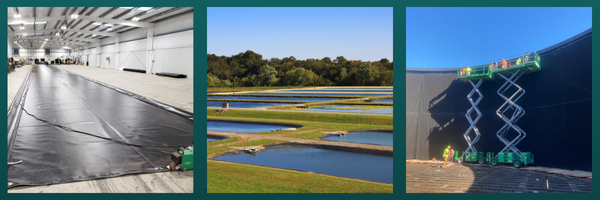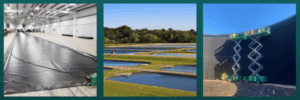When it comes to industrial and environmental applications, material selection plays a crucial role in ensuring longevity, flexibility, and overall performance. Linear Low-Density Polyethylene Reinforced (LLDPE-R) has emerged as a top-tier choice for geomembranes and flexible membrane liner (FML) fabrics due to its superior properties. From enhanced puncture resistance to chemical resilience, LLDPE-R stands out in the world of technical textiles. But one of its most valuable attributes is its exceptional cold bend performance, making it a reliable alternative to other polymers like HDPE.
The Value of LLDPE-R’s Cold Bend Properties
One of the defining features of LLDPE-R is its ability to remain flexible in extremely low temperatures. Unlike some traditional polymers that become brittle and prone to cracking in cold environments, LLDPE-R maintains its structural integrity even in freezing conditions. This is particularly beneficial for:
- Outdoor Installations: In cold climates, materials that lose flexibility are susceptible to fractures. LLDPE-R’s elasticity allows it to adapt to temperature changes without losing performance.
- Water Containment & Geomembranes: For applications such as pond liners, landfill covers, and canal liners, cold resistance is critical to prevent cracking and leakage during seasonal temperature fluctuations.
- Fish Hatchery & Aquaculture: LLDPE-R is an excellent candidate for fish hatcheries and aquaculture because there is very little chance of chemical migration from within the membrane, ensuring a safe and stable environment for aquatic life.
- Construction & Infrastructure Projects: Materials used in containment barriers and protective layers need to withstand temperature extremes. LLDPE-R provides long-term reliability where others might fail.
Why LLDPE-R is a Better Alternative to HDPE
Many industries traditionally rely on High-Density Polyethylene (HDPE) for applications like waterproofing, containment, and packaging. However, LLDPE-R offers distinct advantages over HDPE:
LLDPE-R vs. HDPE
- Superior Cold Flexibility: While HDPE is known for its strength and rigidity, it lacks the flexibility of LLDPE-R, making it more susceptible to stress fractures in extreme cold.
- Ease of Installation: LLDPE-R’s pliability makes it easier to install and conform to complex surfaces, reducing the need for excessive welding or seams in geomembrane applications.
- Better Impact Resistance: LLDPE-R can absorb impacts better than HDPE, making it more suitable for applications requiring resistance to mechanical stress and environmental forces.
Factory Fabricated Panels for Enhanced Performance
Most LLDPE-R reinforced membranes can be manufactured as factory-fabricated panels, allowing for the majority of welds to be completed in a climate-controlled environment. This controlled setting ensures higher-quality welds, reducing the risk of installation errors and improving overall seam integrity. By minimizing field welding requirements, factory fabrication enhances durability, reduces labor costs, and accelerates installation time, making it a highly efficient option for various applications.
LLDPE-R’s Role in the Future of Technical Textiles
As industries move towards more sustainable and high-performance materials, LLDPE-R is proving to be a game-changer in flexible membrane applications. Its unique combination of flexibility, chemical resistance, cold temperature performance, and durability makes it an ideal choice for geomembranes, water containment solutions, and aquaculture projects. Companies looking to improve the longevity and efficiency of their materials should consider LLDPE-R as a superior alternative to HDPE.
E Squared Technical Textiles’ LLDPE-R Solutions
At E Squared Technical Textiles, we specialize in developing advanced LLDPE-R geomembranes that redefine industry standards. We produce 30 mil, 36 mil, and 45 mil reinforced LLDPE, offering a variety of grades to meet diverse needs. Our economic grade is ideal for outdoor applications with durations of 3 years or less, while our high-performance versions can withstand up to 20 years of exposure and pass GRI-GM25. We also offer a specialized LLDPE-R variant designed and tested for fish hatcheries, ensuring very low toxicity to aquatic life. Whether you’re working on an environmental containment project or looking for a more resilient and cost-effective solution, LLDPE-R is a material worth considering.
For more information on E Squared’s LLDPE-R geomembranes and how it can enhance your applications, visit our website or contact us today!


